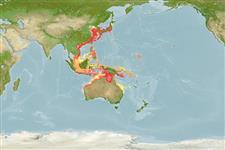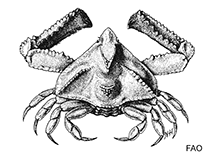Enoplolambrus validus (De Haan, 1837)
Strong elbow crab| Native range | All suitable habitat | Point map | Year 2050 |

|
| This map was computer-generated and has not yet been reviewed. |
| Enoplolambrus validus AquaMaps Data sources: GBIF OBIS |
Google image | No image available for this species;
drawing shows typical species in Parthenopidae.
Classification / Names Κοινά ονόματα | Συνώνυμα | CoL | ITIS | WoRMS
Malacostraca | Decapoda | Parthenopidae
Environment: milieu / climate zone / εύρος βάθους / distribution range Οικολογία
; εύρος βάθους 15 - 200 m (Αναφ. 125642). Subtropical; 42°N - 28°S, 103°E - 171°E
Distribution Χώρες | Περιοχές FAO | Οικοσυστήματα | Παρουσίες | Εισαγωγές
Central and Eastern Indo-Pacific: from Singapore to Samoa in the east, north to Japan and Korea and south to Moreton Bay, Australia. Subtropical to temperate climates.
Length at first maturity / Μέγεθος / Weight / Age
Γεννητική Ωρίμανση: Lm ? range ? - ? cm Max length : 8.2 cm BL αρσενικό/απροσδιόριστο; (Αναφ. 83447); 7.7 cm BL (female)
Life cycle and mating behavior Γεννητική Ωρίμανση | Αναπαραγωγή | Γεννοβολία | Eggs | Γονιμότητα | Larvae
Main reference
Αναφορές | Συντονιστής | Συνεργάτες
Hong, S.Y., K.Y. Park, C.W. Park, C.H. Han, H.L. Suh, S.G. Yun, C.B. Song, S.G. Jo, H.S. Lim, Y.S. Kang, D.J. Kim, C.W. Ma, M.H. Son, H.K. Cha, K.B. Kim, S.D. Choi, K.Y. Park, C.W. Oh, D.N. Kim, H.S. Shon, J.N. Kim et al. 2006 Marine invertebrates in Korean coasts. Republic of Korea, Academy Publishing Company, Inc. 479 p. (Αναφ. 83447)
IUCN Red List Status
(Αναφ. 130435: Version 2025-1)
CITES status (Αναφ. 108899)
CMS (Αναφ. 116361)
Threat to humans
Human uses
αλιεία: Εμπορικό(ά)
| FishSource | Η θάλασσα γύρω μας
Εργαλεία
Περισσότερες πληροφορίες
Σύσταση δίαιτας
Κατανάλωση τροφής
Θηρευτές
Διαδικτυακές πηγές
BHL | BOLD Systems | CISTI | DiscoverLife | FAO(Publication : search) | Fishipedia | GenBank (genome, nucleotide) | GloBI | Gomexsi | Google Books | Google Scholar | Google | PubMed | Δέντρο Ζωής | Wikipedia (Go, αναζήτηση) | Zoological Record



